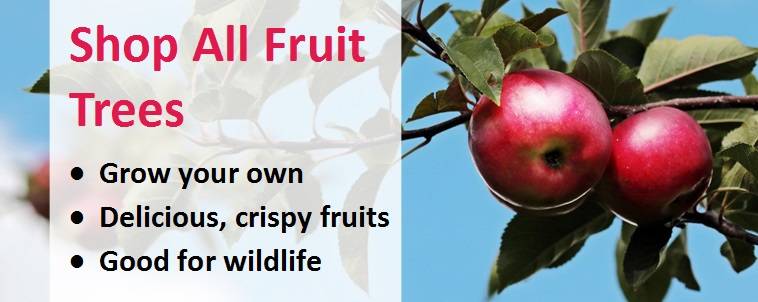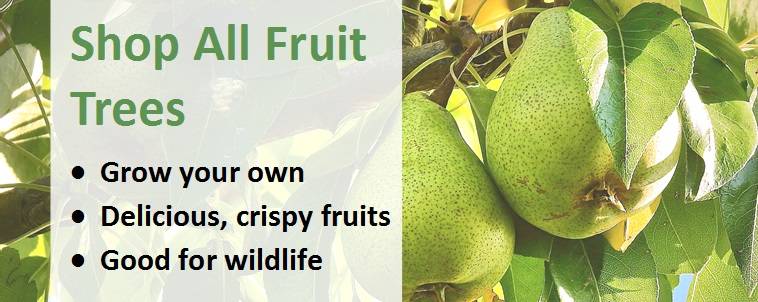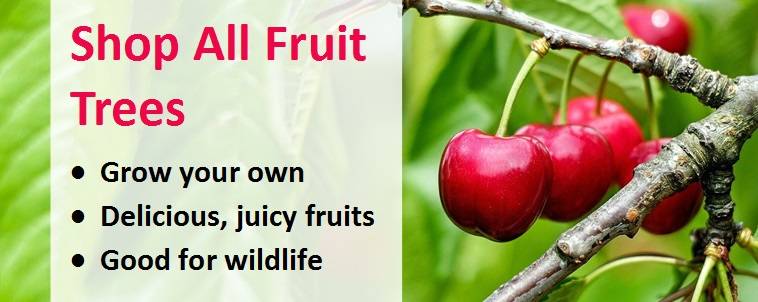Check Here Before Buying – Pot Size Matters...Not all websites offer the same. Plants in a 2-litre pot have twice the root system of a P9 or 1 litre pot.
How to plant, grow and care for fruit trees
Planting advice
Container grown fruit trees can be planted at any time of year providing there is not a frost and the ground is not waterlogged, although autumn planting is preferable, as they need less watering than ones planted in spring or summer. Bare root trees can be planted from late autumn to the end of winter as this is when the tree is in its dormant stage. If the ground is frozen, or you can't plant for some other reason, 'heel' in your fruit tree in a shallow trench, angling the trunk and covering the roots at the bottom of the trunk with moist soil.

Choose a sunny, sheltered position well away from any frost pockets and avoid poorly drained or shallow soils. We recommend growing your fruit tree(s) along a south-facing wall or fence. The wall will soak up the heat of the sun, allowing for a longer ripening time. When you're ready to plant, give the roots of the tree a good soaking before planting. Be careful to ensure the depth of the planting hole is adequate to accommodate all of the root system - it should be the same depth and one-third wider than the root ball. Once you've finished digging, break up the bottom of the planting hole with a fork and build in plenty of well-rotted organic matter such as manure, leaf mould or well-rotted garden compost. At this stage, recheck the depth of the planting hole using a cane or rod; it is vital to match the depth of planting to the depth at which the tree has been grown on our nursery.
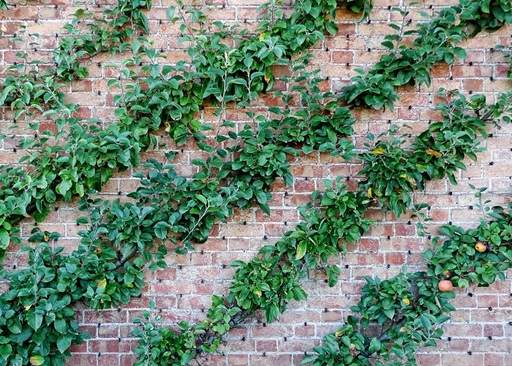
Apple trees grown as cordons against a wall
Next, carefully place the root ball of your new fruit tree into the hole, apply a general purpose fertiliser to the soil you've just dug out, then backfill into the planting hole again and firm with your boot. If you are planting a bare root fruit tree, as the topsoil is backfilled, shake the tree up and down to allow the soil to filter around the roots. Once you've finished backfilling, ensure that the tree remains upright and the graft union (the point when the fruit variety is grafted onto the rootstock) is not buried. Drive a sturdy stake into a point on the windward side of the hole that will match up well with the tree once planted. Attach the tree to the stake using a tree tie, remembering to use a buffer to prevent chaffing.
Finally, tidy the planting hole and water thoroughly. Apply a thick mulch of organic matter, taking care not to allow it to accumulate around the crown of the tree. The ground mulch applied at planting time should be repeated annually - this should help to retain moisture and smother weeds so there is no competition in the vital root active areas.
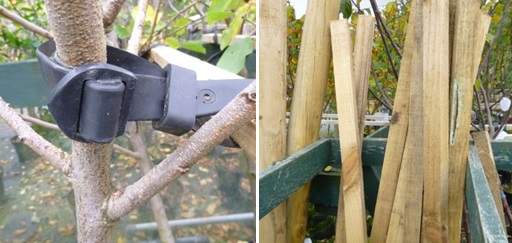
Our Planting Kit with stake, tree tie and Osmocote tablets is perfect to give your new fruit tree the best start
If container growing a very dwarf fruit tree, use a soil-based potting compost (John Innes No 3 is ideal) to half-fill your pot or tub, then place your tree on top. Finish by filling in the pot/tub with more compost to the base of your tree, ensuring you do not cover the crown, and water thoroughly.
Pruning
Annual pruning of fruit trees is necessary to remove congested and diseased shoots, encourage new growth on which new buds will form and increase the productivity of your tree. Trees that are not pruned become less productive and congested with old branches and diseased shoots. Pruning is easy, even for the novice gardener - use a pair of bypass secateurs to create an open goblet shape with a framework of about 5 main branches. Thought is needed in setting out the basic framework of the tree and reducing shoots by about one-third to a bud in an outward pointing direction. Most fruit trees should be pruned in late autumn and winter, supplementing with light pruning in summer if absolutely necessary in smaller gardens. Cordons and other forms of intensive fruit trees should be pruned during the summer months from the third week in July or in areas with heavy rainfall, further north or in wet summers from the second week in August. Summer pruning involves removing the fresh, current seasons growth back to a certain point.
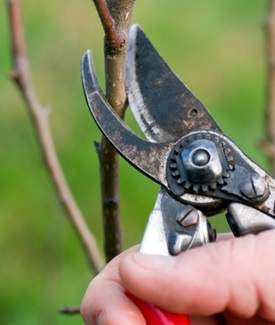
Pests & Diseases
Choosing a fruit tree with a degree of disease resistance is the important first step, particularly if you wish to grow fruit organically or if you live in a part of the country where climate favours certain diseases; all of the varieties we stock are suitable. To further defend your tree from moths and caterpillars, apply a grease band 45cm (18 inches) above soil level to the trunk of your tree and tree stake in late autumn. This will protect your fruit from moths that may otherwise destroy your fruit and leaves. The grease band is basically a glue or sticky paper that prevents windless female moths from reaching the branches of the tree to mate, thereby preventing caterpillars which would eat the leaves and fruit of your precious fruit tree. If you have the time, we also recommend using an oil-based winter wash in December or January to kill off any over-wintering pests.
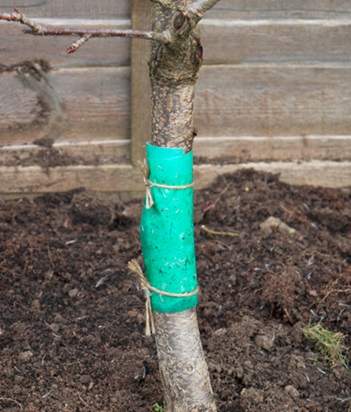
Feeding Fruit Trees
Fruit trees require balanced supplies of nutrients to maintain good results. Whilst not every tree needs fertilising every year and not in the same amounts, if your fruit tree either failed to produce an abundant crop in the previous year or is not demonstrating the expected annual growth rate (bearing in mind your local growing conditions), feeding your fruit tree is recommended. Fruit trees are best fertilised just before bud break at the end of winter / beginning of spring using an organic high nitrogen fertiliser - chicken manure or fish, blood and bone plant food are perfect. Alternatively, use a specialist fruit tree fertiliser; the NPK numbers show the percentage of each nutrient, Nitrogen, Phosphorus and Potassium which it contains.
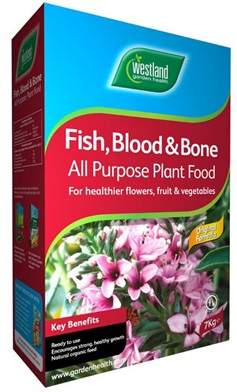
Start fertilising a foot away from the trunk, not right next to it and spread the fertiliser out evenly, all the way out to the drip line (the perimeter of the trees farthest reaching branches). Another effective but trickier method is to drill a series of small holes within the drip line perimeter so the fertiliser can sink down into the soil around the roots more easily. Drill the holes to a depth of 15cm (6 inches) and position them 12-18 inches apart from 30cm (1 foot) away from the trunk, all the way to the drip line. Sprinkle a little bit of the fertiliser into each hole, then cover over with soil.
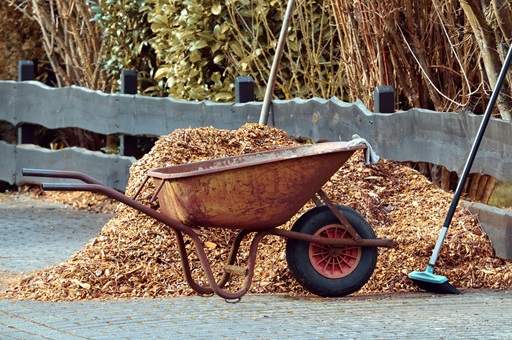
Storing your Fruit
During the harvesting season, you'll usually find you have a lot more fruit than you can use at once. In these situations its useful to store your fruit to be consumed at a later date, remembering that early ripening fruit trees tend to only store for a few weeks, whilst later ripening varieties will store for several months over the winter. Store your fruit in a cool, dark, frost-free place - a shed in a shady part of the garden or a garage are often the most suitable places. Ideally, place your fruit within a strong wooden box with slats on the base and side walls for good air circulation - stackable boxes can be used to help save space. Ensure your boxes are clean before use to prevent your fruit going mouldy or becoming infected.
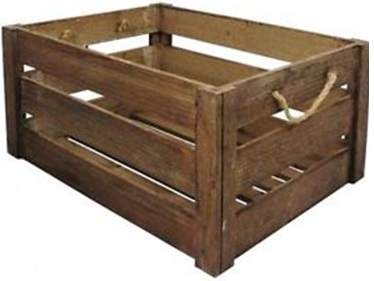
Place your fruits into the box stalk-down, leaving a small gap between each fruit. Ensuring the fruits do not quite touch each other will mean that if one happens to rot it should not spread to other fruits nearby. Try to avoid placing the boxes right into the corner of your shed or garage where there is not any air movement, instead move them slightly away so you get air movement around them. Some people choose to wrap stored apples - we do not recommend this as it prevents you from easily spotting when they ripen. Check stored fruits regularly so you can see them ripening and determine the best time to eat; doing so will also help you to spot any that start to rot early on so they can be removed and not allowed to spread to the other fruit.
Share this page:

